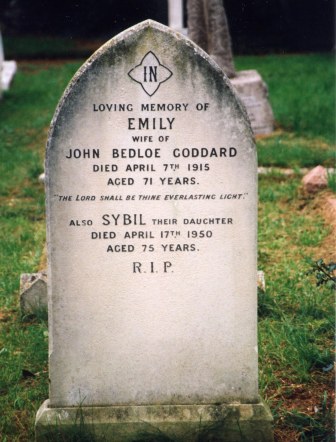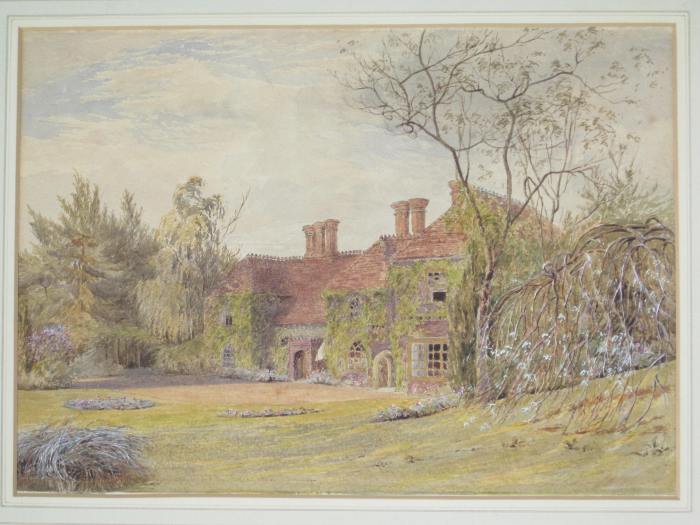John Bedloe Goddard 1838-1896 v Emily (nee Moore) 1844 – 1915
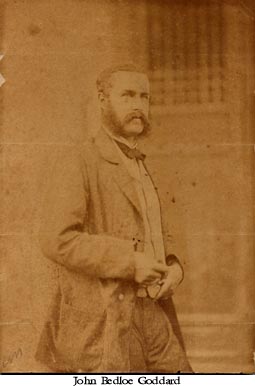
in Hong Kong c.1860
John Bedloe is the eldest of the three artist siblings, the children of John Bryer and Eliza. He was born at Christchurch in Tyneham House and studied in his teens under George Fripp of the Royal Water Colour Society. John’s forte was scenic painting in watercolours.
He spent much of his early life in China with the Consular Service of the British Government. He was appointed Student Interpreter H.M.B. Consular Service at Hong Kong in 1859 having joined the Service the year before at the age of 20. He had a number of postings at Canton and Kowloon before being appointed Third Assistant at Tienstsin in 1861. Four years later he had been promoted to Acting Vice Consul at Taku under Sir Challoner Alabaster who coincidently had a home in Boscombe near to Christchurch.
The Kowloon Peninsula was ceded to Great Britain in the same year that John was posted to Hong Kong and Hong Kong itself had been ceded to us in 1841. Canton, a large provincial town just north of Hong Kong, had been the main trading port for British merchants before Hong Kong was purchased. Taku (Dagu), where he was posted, is on the Gulf of China at the mouth of the river Peiho where forts had been constructed to protect the town of Tientsin (Tienjin), which, in turn, guarded the approaches to Peking (Beijing). It was just one year after John arrived in China that British forces looted and destroyed the Summer Palace near Peking in reprisal for the killing of a number of British officials who headed north to negotiate the terms of cessation of Kowloon. Lord Elgin, now well known for his “purchase” of the Elgin Marbles, led the party.
After his first five-year tour in the Consular Service, John married at Lymington in 1864, a girl he had met only once before – Emily, daughter of a Lymington solicitor, Edward Horatio Moore. Their early family were all born at the British Settlement near Tientsin. The first, John Edward, in 1866 and second, Frederick James the following year but he lived just two months. A third son, Harry Bryer, was born in 1868 and died from hooping cough at Christchurch aged just 17 months. Because of poor health John had to retire early from the Service returning home in 1871. He had received his last promotion to First Class Assistant some three years earlier
John Bedloe’s next offspring, Emily Margaret, was born in December 1871 at Lymington. This gives us a clue as to his financial health and lack of assets on his return from the East. 19 Captains Row, Lymington was the family home of his wife Emily. The 1871 census reveals that apart from Emily’s parents there were other residents at the Moore family home. They consisted of Emily, her first son John Edward and Emily Margaret. Ethel and Sybil were born at Christchurch in 1874 and 1875.
It would appear that Emily Margaret was a very religious lady as a script in her nephew, Joseph Bedloe Goddard’s bible, which she had given to him at his baptism in 1914, records much of her views on the birth and crucifiction of Christ.
During his time in Hong Kong and China John spent many happy hours capturing the scenery on canvas. There are a number of these in family hands. One tells that in 1861 he was on board the Orphir a clipper, on his way back from China. During the voyage he sketched the Nagasaki coastline and Table Mountain. Other charming depictions include the Temple of Cofucius at Canton, the Great Wall of China and many of Kowloon and Hong Kong. The “Orphir” was built in Dundee in 1852 and in 1862 Lloyd’s Register records that it sailed from Dundee to the East Indies and stopped at Shanghai.
His premature return from China marked the beginning of a tragic decline in the family circumstances. Having first stayed at his wife’s family home at 19 Captain Row, Lymington, he then found rented accommodation at Albert Villas, Christchurch. The house at Rotten Row, Purewell, Christchurch, named “Magnolia,” was at this time occupied by his father, John Bryer Goddard and family, until his death in 1880 and thereafter by his mother and sisters, Eliza and Amelia.
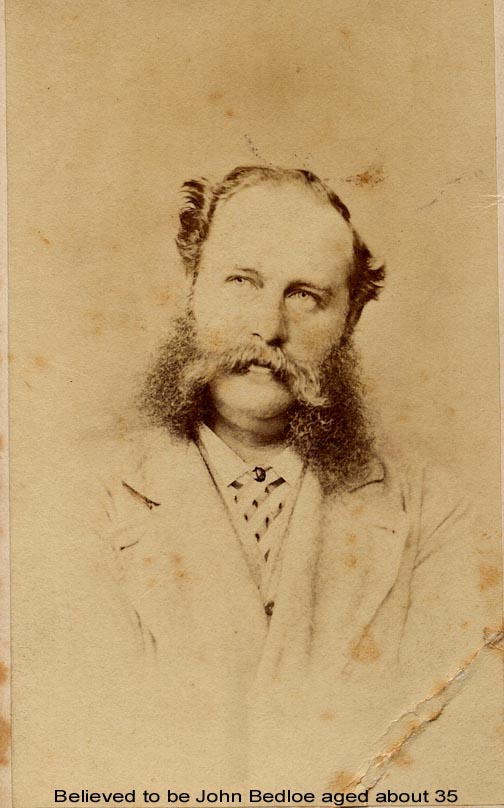
John turned to his love of painting to secure some sort of income. The first evidence of this is at an exhibition held by the Royal Society of British Artists in 1875 where he showed two paintings of Christchurch. By that time, he had found residence at Avenue Cottage, Standpit, Christchurch. He was exhibiting in Christchurch again at the RSBA in 1876.
Dora and Olive, his fourth and fifth children, were born at Christchurch in 1878 and 1880, Dora living just 10 months. It was around this time that the family moved to Coddenham Suffolk to live with his sister-in-law Bessie and her husband Fred Gull. Fred was a surgeon, public vaccinator and District Medical Officer. He also acted as surgeon to the Workhouse. One need not guess as to the reason for this move for Fred lived in a very large house which, by tradition, was the doctor’s house in Coddenham and so the Gulls could easily accommodate John’s family.
This is John’s painting of the house which was called, “The Shrubbery”. It was used as a base by John and he and his family travelled around the country while he painted visiting Norfolk, the Wye Valley, Dorset and Cornwall. He exhibited with the Ipswich Art Club in the 1880’s and two of his watercolours are held by Ipswich Museum. The family stayed at Coddenham for about four years. Most of his family were still at Coddenham in 1881 and that included John’s wife Emily, and daughters Ethel, Sybil and Olive. The house looked much the same when I visited in 2006.
On their return to Christchurch they lived at 11 Stour Road, again rented. Emily Margaret (whose nickname was Daisy) had left the family circle by 1881 and she was brought up at Lymington by the Moores, her mother’s family, into which Ethel married her cousin, Frederick Charles Hicks Moore. At the benevolent request of the Gulls, Olive left Stour Road and returned to them and they attended to her upbringing. In spite of their difficult circumstances her father was against this course because he had, as he said, already lost one daughter – Emily Margaret.
John’s final son, Frederick Bedloe, was born at Coddenham in 1885 and his last daughter, Dorothy at Christchurch in 1887 when her father had reached the age of 49. Dorothy at the age of fourteen and some five years after her father’s death, went to live with her brother-in-law, Frederick Charles Hicks Moore at Clapham. Her sister Ethel had died the year before in 1900 and had left a young son aged four and no doubt Dorothy helped to care for him.
It was in 1885 that John met a man called Frederick Grimwade. He was an agent for an avid art collector and dealer in Australia called Alfred Felton. Grimwade had agreed to try to sell some of John’s paintings in Australia. On his return there, John sent a case of his paintings by steamer to Grimwade who confirmed they had been received in February 1886. This letter is in the archives at the University of Melbourne.
It also states: “I have shown them to several people but this market is so full of pictures that I can hardly get any one to look at them. There are consignments of pictures constantly coming here from England and the Continent, and almost weekly sales of pictures are held either at private houses or at dealer’s shops, and the prices realised are very low. I have sold No.4 “A spring morning at Shrubland” for 8 guineas but this is the only one I have sold. I can only say that as opportunities offer I will sell the others, and directly they are sold, remit you the money.” It is not known whether there were other successes.
The original letter
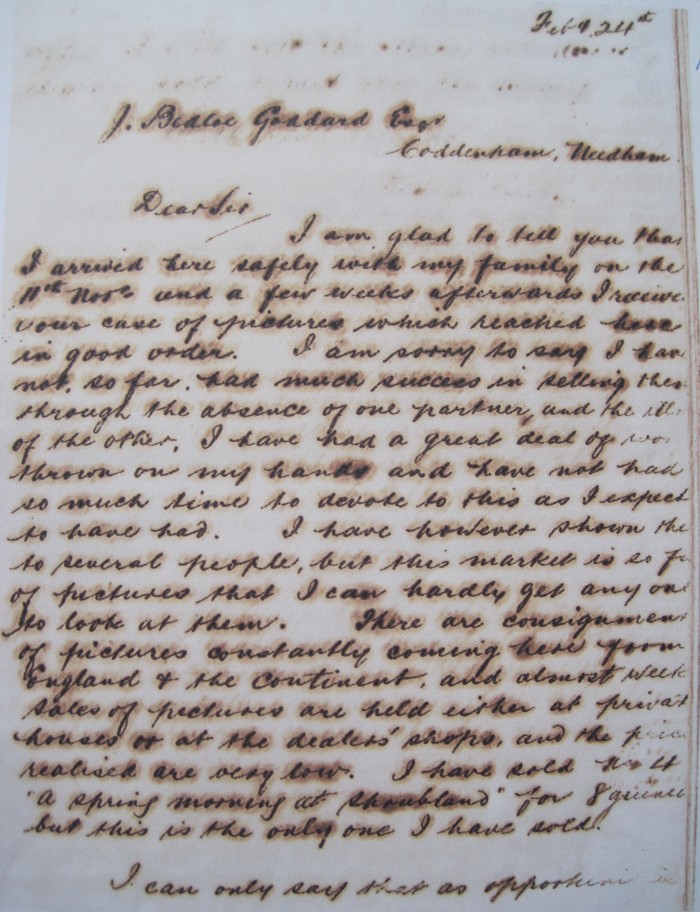
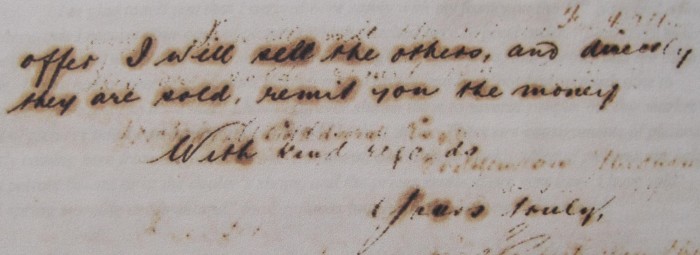
The 1880’s were probably John’s most prolific period. He exhibited at Christchurch and the RSBA and won first prize for the best watercolour at an exhibition held by Bury & Suffolk Fine Art Society. He also taught privately and at Christchurch School of Art. So the story goes he could often be seen riding around the countryside on a tricycle with his painting easel slung across his back which aroused a certain amount of comment from those in a more fortunate position. In 1891 his wife and five of his children were living at Stour Road, Olive aged 20 still lived with the Gulls in Coddenham and Emily Margaret lived with Dora Moore at Christchurch.
A very grand funeral was held in Ipswich in 1884 following the death of Harry Gage Moore G.P., Frederick’s father. A number of Goddards attended. In the sixth Brougham rode John Bedloe and Emily with Fred Gull and Dora Moore. Flowers were sent by John, Mr & Mrs Gull and Miss Daisy Goddard of Lymington, (the nickname given to Emily Margaret). She received a legacy of £10 from her grandfather, Edward Horatio Moore, on his death in 1888.
The year 1890 was a busy one for John. He sent some seventy paintings to The Mutual Improvement Society’s annual conversazione and in that year was one of a number of guests entertained by the Mayor and Mayoress of Christchurch at the Bath Hotel in Bournemouth for the visit of the Prince of Wales and Prince George. They had an excellent view of the royal procession. Meanwhile Emily had put an advertisement in the Christchurch Times as follows: Good General servant wanted immediately; must understand plain cooking. Also strong willing GIRL, 17, to take care of two children and assist in housework.”
That is to say Frederick Bedloe aged five and Dorothy four. A second notice in the local paper reveals that Emily had lost a small tabby kitten and was looking for its return.
John’s last recorded recognised exhibitions were in 1893 at the Royal Institute of Painters in Watercolours London Gallery and at the Royal Society of British Artists and the Bournemouth Art Society where he showed with his sister Amelia.
John died in 1896 aged 57 at Stour Road after severely injuring his heart while riding. He is buried in the Christchurch Cemetery. During his life he produced many paintings; ninety eight have been positively identified of which forty are in the family, eight are owned by the Red House Museum, Christchurch, one by Russell-Cotes Art Gallery & Museum, Bournemouth and two by Ipswich Borough Museum.
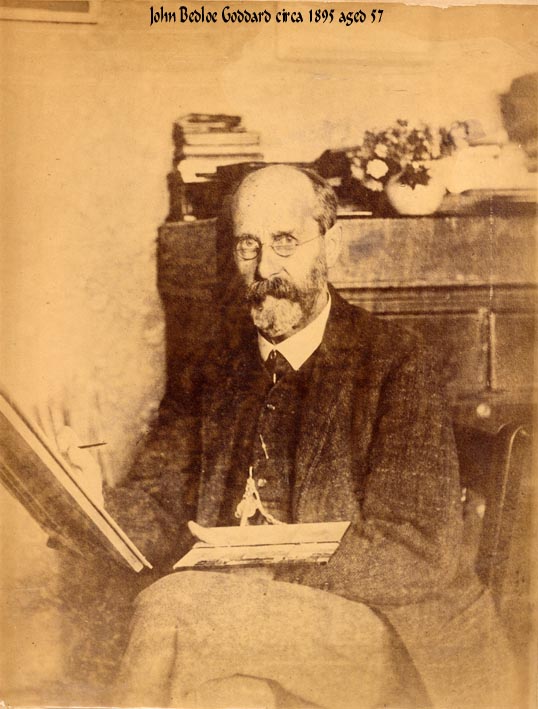
By his will dated 1891, he left the whole of his estate to his wife, Emily. “The whole of his estate” was animate and consisted of seven children, four over 21 years of age – John Edward, Emily Margaret, Ethel and Sybil and three under 21, Olive aged 15, Frederick Bedloe aged 10 and Dorothy aged 9 years. His estate effects were worth £115. After his death, his wife endevoured to make ends meet, without success, at the rented Stour Road house, by keeping poultry. The younger members of the family were largely educated on charity. An old family friend educated Frederick Bedloe, a Miss Braithwaite. Dorothy’s later education was due to the Artists Benevolent Fund.
Around 1898, with the sum of £100 raised by subscription, a boarding house was started at 95 St. James Road, Brixton. This was where Emily’s daughter Ethel lived with husband Frederick Charles Hicks Moore. They had married at Christchurch the year before and had a son Frederick Harry Bedloe. This venture also met with no success, the home was broken up and the furniture sold by auction at Christies. In 1901 Emily, and her son Frederick Bedloe, were residing as visitors at the home of a Mrs Emilie Philips in Plumstead near Woolwich. She was their mother’s niece. Emily then took employment as a housekeeper and was partly maintained by a family subscription of one shilling a week. Her son, Frederick Bedloe, who had entered Lloyds Bank, was later able to make a new home for her in London. Her daughter, Sybil, who had been working away, now went back to live at home. At the start of the First World War, Frederick Bedloe was called up and at his request, Dorothy, who was qualified and doing private nursing, returned home as well. Emily, lived for a while with her eldest son, John Edward and his wife at Gerald Road, Bournemouth probably not long before her death. In spite of the hard times and difficulties to which she had been subjected, Emily lived to the age of 71 years and died at 65 St. Helen’s Gardens, North Kensington, in 1915.
Now to the children, Emily Margaret took up teaching and, at the age of 26 in 1897, started at a school in Harlesden and then taught at schools in Somertown, North Kensington, Hoxton and Hammersmith. By 1911 she was living at 42 St. Lawrence Road, Kensington with her aunts Dora and Margaret Moore. Since the death of their father Edward Horatio Moore they had moved from Lymington to Kensington. Emily Margaret had moved to 58 St. Mark’s Road, Kensington by 1915. She retired as a school Head Mistress. She died at Wantage Berkshire in 1960 aged 89.
Ethel Goddard was an accomplished pianist giving lessons on playing and the theory of music. She married her cousin, Frederick Charles Hicks Moore at Christchurch in 1897. Her husband was an accountant by profession and lived in Highgate at the time of their marriage. He was born in Ipswich, her mother’s home town. At the time of Ethel’s death in 1901 he was Secretary to a Coal Factor Company in Clapham and retired from there pre 1941. He had married a second time, before 1911, Eva Gwendoline and they had a son together – Charles Edward Montgomery Moore. The only child of Ethel and Frederick Charles was Frederick Harry Bedloe Moore who was born at their home in Brixton. He was killed in the first world war and his story follows.
Ethel, who had married her cousin, Frederick Charles Hicks Moore at Christchurch in 1897, died in London in 1900. Frederick was an accountant by profession living at Highgate in London at the time of their marriage. At the time of Ethel’s death he was Secretary to a Coal Company as born at 7 Museum Street, Ipswich, his mother’s home town. His father, Harry Gage Moore was a surgeon. Agnes Mary Moore his mother witnessed the marriage. Their only child, Frederick Harry Bedloe Moore, was born at their home in St. James Road, Brixton. He was killed in action in France in the First World War. His story follows.
On the death in 1925 of Agnes Mary Moore, the widow of Dr Harry Gage Moore, those attending the funeral in Ipswich included the Misses Goddard – Emily, Margaret, Olive, Sybil and Dorothy.
Dorothy completed a three-year Nursing Training Course at Hammersmith West London Hospital. She received the “Trained Nurse’s Certificate” on 22nd April 1912 at the age of 25. In 1901 she was living with her sister-in-law Ethel at Clapham in the house owned by her brother-in-law Frederick Moore. Sybil Goddard remained a spinster and lived with and kept house in Kensington for her sister Dorothy. After her sister’s death Dorothy lived in London with a very old friend, Miss Kathleen Stevens, whom Dorothy had once nursed. She then moved to live with her dear friend Vera Stratton in Andover where she died in 1974 aged 87. Her estate was valued at £2107.
Olive devoted many years of her life to work in a leper colony and hospital in Uganda, in which she died in 1949 at the age of 69 years. Frederick Bedloe’s story comes later. The members of John Bedloe’s family buried at Christchurch Cemetery are John and his wife Emily and their children Sybil, Dora and Dorothy.
John Bedloe Goddard gravestone at Christchurch Cemetery.
